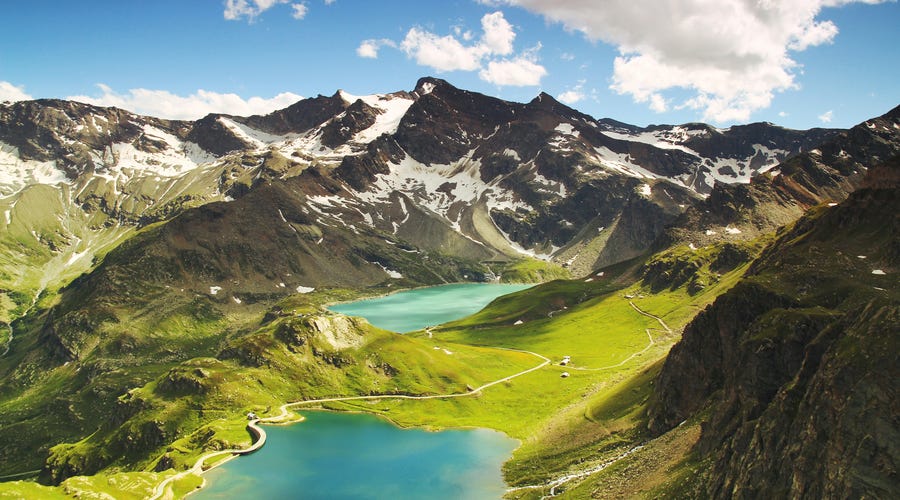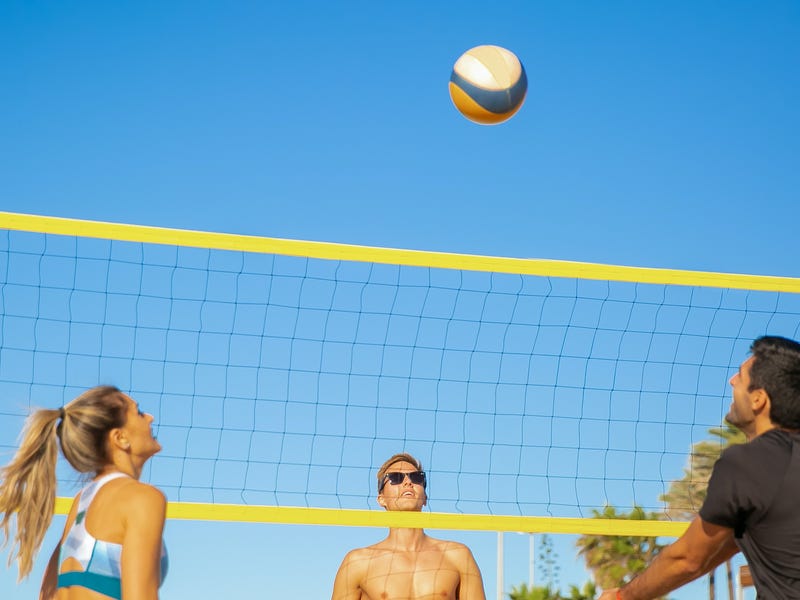Mount Vesuvius in Naples. Historical canals in Venice. Tiber River in the Roman capital. These are just three examples of Italy’s rich geography.
In fact, Italy has a little bit of everything when it comes to landforms and bodies of water! There are beautiful sights to experience in every region, so it’s only natural to talk about all that the most beautiful peninsula has to offer.
Maybe you’re learning Italian as a hobby, or perhaps you’re planning a trip to Italy and want to brush up on some vocabulary and phrases. Whatever the reason, it’s important to be able to talk about different landforms in Italian. Geography is so ingrained in Italian history and way of life, and understanding it can only help you get better acclimated with the language and culture.
This boot is made for…
Just think about it: even the shape of the country itself is unique: a boot! This boot isn’t made for walking, though. It’s made for kicking! If you look at the map, you’ll notice that the mainland seems to be “kicking” one of its two separate islands: Sicily. Italy is a peninsula - or a piece of land almost surrounded entirely by water while remaining connected to a mainland. Although 116,350 square miles might not seem that big, the Italian peninsula contains a wide array of geographical features.

Before we journey into the different landforms, let’s take our first step by looking at some basic terms. Keep in mind that the Italian language takes masculine and feminine articles, which will be used throughout the article.
| English | Italian | IPA | Pronunciation |
|---|---|---|---|
| Landform | Morfologia Terrestre | morfoloˈdʒia terˈrɛstre | mor-phoh-lo-gee-ah teh-res-tre |
| Bodies of Water | Massa d’acqua | 'masːa di 'akːwa | mas - ah - dee - ahk - wa |
| Geography | Geografia | dʒeoɡra'fia | je - oh - gra - fee - ah |
Features of Earthly geography in Italian
With some of the most beautiful geographical wonders at our fingertips, we need to start somewhere! First, let’s cover the most common landforms and bodies of water that you should know. Even if you’re not a geography buff, this list will prove useful whether you’re learning about Italy from home or actually touring around the peninsula.
| English | Italian | IPA | Pronunciation |
|---|---|---|---|
| River | Il fiume | ‘fjume | fee-ew-meh |
| Mountain | La montagna | mon'taɲa | mon-tan-ya |
| Forest | La foresta | fo'rɛsta | foh-res-ta |
| Ocean | L’oceano | o'tʃɛano | oh-sheh-ah-no |
| Valley | La valle | 'valːe | vah-leh |
| Desert | Il deserto | de'zɛrto | de-ser-toe |
| Hill | La collina | ko'lːina | koh-lee-na |
| Island | L’isola | 'izola | ee-so-la |
| Beach | La spiaggia | 'spjadːʒa | spee-ya-jah |
| Volcano | Il vulcano | vul'kano | vul-cahn-oh |
Going forward, keep in mind that there will likely be some overlap between words included in certain sections. Ready to go into more detail? Get your geology hats on - it’s time to adventure out into Italy’s beautiful landscapes!
Coastal and oceanic landforms in Italian
Coastal and oceanic landforms are all about where the land meets the sea. Italy is home to many rocky coasts as it looks out into the Mediterranean Sea, and boasts a coastline of almost 5,000 miles!
Whether you’re driving along the Amalfi coast or near the high point of the Adriatic Sea, the Italian coastal landforms are definitely worth noting. Here are a few words that pertain to coastal and oceanic landforms, along with some pronunciation tips.

| English | Italian | IPA | Pronunciation |
|---|---|---|---|
| Archipelago | l’arcipelago | art∫i'pelaɡo | ar-key-pe-la-go |
| Atoll | l’atollo | a'tɔlːo | ah-toll-oh |
| Barrier Island | L’isola barriera | 'izola ba'rːjɛra | ee-so-la bah-ree-eh-ra |
| Bay | La baia | 'baja | bay-ah |
| Beach | La spiaggia | 'spjadːʒa | spee-ya-jah |
| Bight/Bend | La ansa | 'ansa | ahn-sa |
| Channel | Il condotto | kon'dotːo | cohn-dot-oh |
| Cape | Il capo | ˈkapo | cah-poh |
| Cliff | La scogliera | sko'ʎɛra | sko-lee-er-ah |
| Coast | La costa | 'kɔsta | caw-sta |
| Continental Shelf | La piattaforma continentale | pjatːa'forma kontinen'tale | pee-at-ta-for-ma kon-ti-nen-tal-eh |
| Coral Reef | La barriera corallina | ba'rːjɛra koral’lina | bah-ree-eh-ra coh-rah-lee-na |
| Cove | L’insenatura | insena'tura | een-sen-a-two-ra |
| Dune | La duna | 'duna | do-na |
| Estuary | Il estuario | estu'arjo | es-two-are-ee-oh |
| Forest | La foresta | fo'rɛsta | fo-res-ta |
| Gulf | Il golfo | 'ɡolfo | gol-fo |
| Headland | Il promontorio | promon'tɔrjo | pro-mon-to-rio |
| Inlet | L’insenatura | insena'tura | een-sen-a-two-ra |
| Island | L’isola | 'izola | ee-so-la |
| Islet | L’isolotto | izoˈlɔtto | ee-so-lot-toe |
| Isthmus | L’istmo | 'istmo | eest-mo |
| Lagoon | La laguna | la'ɡuna | la-goo-na |
| Oceanic basin | Bacino oceanico | ba'tʃino otʃe'aniko | bah-cee-no oh-she-ah-nee-co |
| Peninsula | La penisola | pe'nizola | pe-neen-so-la |
| River Delta | Il delta del fiume | 'dɛlta del fjume | del-ta del fee-ew-meh |
| Sea Cave | La grotta marina | 'ɡrɔtːa ma'rina | grot-ta ma-ree-na |
| Seaport | Porto di mare | 'pɔrto di mare | por-toe di ma-reh |
| Shoal | La secca | 'sekːa | sek-kha |
| Shore | La costa | ‘kɔsta | caw-sta |
| Strait | Lo stretto | 'stretːo | stret-toe |
| Tide Pool | La pozza di marea | ‘potːsa di ma'rɛa | poz-zah di ma-reh |
| Volcanic Arc | L’arco vulcanico | ‘arco vul'kaniko | ar-ko vul-cahn-ee-ko |
Erosion landforms in Italian
Erosion landforms are pretty rough and rugged thanks to natural damage from water or air, but they’re breath-taking all the same! This group contains some important examples, like canyons and caves.

| English | Italian | IPA | Pronunciation |
|---|---|---|---|
| Badlands | I calanchi | ka’lanki | ka-lan-kee |
| Canyon | Il canalone | kana'lone | kan-ah-low-neh |
| Cave | La caverna | ka'vɛrna | ka-ver-nah |
| Cliff | La scogliera | sko'ʎɛra | sko-lee-er-ah |
| Fjord | Il fiordo | 'fjɔrdo | fee-or-do |
| Gully | Il burrone | bu'rːone | bur-oh-neh |
| Hogback | Il dorsale | dor'sale | dor-sah-leh |
| Pediment | Il frontone | fron'tone | fron-toe-neh |
| Ridge | La cresta | 'krɛsta | kres-ta |
| Ridge crossing | La traversata di cresta | traver'sata di 'krɛsta | tra-ver-sah-ta di kres-tah |
| Valley | La valle | 'valːe | vah-leh |
Fluvial landforms
A fluvial landform is shaped by various types of running water, including streams or rivers. They can range in size from small to large, as you’ll see in our examples below.

| English | Italian | IPA | Pronunciation |
|---|---|---|---|
| Bayou | La palude | pa'lude | pah-loo-deh |
| Bench | La panchina | pan'kina | pan-kee-nah |
| Canyon | Il canalone | kana'lone | kan-ah-low-neh |
| Confluence | La confluenza | konflu'ɛntsa | kon-flu-en-za |
| Floodplain | La golena | ɡoˈlɛ.na | go-leh-na |
| Gorge | La gola | 'ɡola | go-la |
| Gully | Il canalone | kana'lone | kan-ah-low-neh |
| Levee | L’argine | 'ardʒine | are-gee-neh |
| Marsh | L’acquitrino | akːwi'trino | ak-wee-tree-no |
| Meander | Il meandro | me'andro | meh-an-dro |
| Rapids | Le rapide | 'rapide | ra-pee-deh |
| River Island | L’isola fluviale | 'izola flu'vjale | ee-so-la flu-vee-ah-leh |
| Spring | Fonte | ‘fonte | phon-teh |
| Strait | Lo stretto | 'stretːo | stret-toe |
| Stream | La corrente | ko'rːɛnte | core-en-toe |
| Towhead | Il banco di sabbia | 'banko di 'sabːja | ban-ko di sab-bya |
| Waterfall | La cascata | kas'kata | kas-ka-ta |
| Watershed | Il spartiacque | sparti'akwe | spar-tee-akwe |
Impact landforms in Italian
Have you ever heard of an “extraterrestrial impact”? It’s actually really cool to picture! You can think of these as landforms that were created by something “extraterrestrial” and have eroded over time.
| English | Italian | IPA | Pronunciation |
|---|---|---|---|
| Crater | Il cratere | kra'tɛre | cra-teh-reh |
| Impact Crater | Il cratere da impatto | kra'tɛre da im'patːo | cra-teh-reh da eem-pat-toe |
| Pit Crater | Il cratere a pozzo | kra'tɛre a potːso | cra-teh-reh a pots-so |
Mountains and glacial landforms in Italian
This section is particularly important for Italy! Whether you love hiking, skiing, or just hanging out in the ski cabin, you’ll never be bored in Italy. The Italian Apennine range extends more than 600 miles across the peninsula, and the famous Alps act as a beautiful border to France.

| English | Italian | IPA | Pronunciation |
|---|---|---|---|
| Crevasse | Il crepaccio | kre'patːʃo | kre-pach-oh |
| Glacier | Il ghiacciaio | ɡja'tːʃajo | gyach-ay-oh |
| Glacier Cave | Grotta del ghiacciaio | 'ɡrɔtːa del ɡja'tːʃajo | groht-ta del gyach-ay-oh |
| Highland | L’altopiano | alto'pjano | all-toe-pyan-oh |
| Hill | La collina | ko'lːina | koh-lee-na |
| Moraine | La morena | mo'rɛna | moh-reh-na |
| Mountain | La montagna | mon'taɲa | mon-tan-ya |
| Mountain Pass | Il passo di montagna | pasːo di mon'taɲa | pas-so di mon-tan-ya |
| Mountain Valley | La valle laterale | 'valːe late'rale | vah-leh la-teh-rah-leh |
| Summit | La cima | 'tʃima | chee-ma |
| Valley | La valle | 'valːe | vah-leh |
Volcanic landforms in Italian
Italy has some of the most active volcanoes on Earth, and if you’re familiar with Italian history, you’ve probably learned about Mount Vesuvius’ catastrophic result on Pompeii. Although its volcanoes could erupt at any time, Italians hold a deep respect for these volcanic landforms.
| English | Italian | IPA | Pronunciation |
|---|---|---|---|
| Caldera | La caldera | kælˈdeə.rə | kal-der-ah |
| Fissure Vent | La fessura | fe'sːura | fess-oo-ra |
| Geyser | Il geyser | ˈɡaizər | gai-ser |
| Lava | La lava | 'lava | lah-vah |
| Lava Lake | Il lago di lava | 'laɡo di 'lava | lah-go di lah-vah |
| Pit Crater | Il cratere a pozzo | kra'tɛre a potːso | cra-teh-reh a pots-so |
| Volcano | Il vulcano | vul'kano | vul-cahn-oh |
| Volcanic Cone | Il cono vulcanico | 'kɔno vul'kaniko | coh-no vul-cahn-ee-ko |
Bodies of water in Italian
The Italian peninsula is not afraid of water, that’s for sure! The country has many large, freshwater lakes, like the famous Lake Garda and Lake Como. Plus, there are approximately 1,200 rivers all throughout the country!

| English | Italian | IPA | Pronunciation |
|---|---|---|---|
| Canal | Il canale | ka’nale | ka-na-leh |
| Channel | Il condotto | kon'dotːo | kon-dot-toe |
| Creek | Il ruscello | ru'ʃɛlːo | ru-schel-low |
| Dam | La diga | 'diɡa | dee-gah |
| Delta | Il delta | 'dɛlta | del-ta |
| Hot Spring | Le terme | 'tɛrme | ter-meh |
| Lagoon | La laguna | la'ɡuna | la-goo-na |
| Lake | Il lago | 'laɡo | lah-go |
| Mangrove | La mangrovia | man'ɡrɔvja | mahn-grow-vee-ah |
| Moat | Il fossato | fo'sːato | foss-ah-toe |
| Ocean | L’oceano | o'tʃɛano | oh-sheh-ah-no |
| Pond | Lo stagno | 'staɲo | sta-nyo |
| Puddle | La pozza | 'potːsa | poz-zah |
| Reservoir | Il serbatoio | serba'tojo | sur-bah-toy-oh |
| River | Il fiume | 'fjume | fee-ew-meh |
| Sea | Il mare | ‘mare | ma-reh |
| Sinkhole | La dolina | do'lina | doe-lee-na |
| Source | Il fonte | 'fonte | phon-teh |
| Swamp | Il pantano | pan'tano | pahn-tah-no |
| Wetland | La zona umida | 'dzɔna 'umido | zo-na ew-mee-da |
Phrases or idioms that contain landforms and geography in Italian
Incorporating geography in Italian via idioms and phrases into conversation is one of the best ways to master not only vocabulary but cultural elements, too! And as you’ll see in the table below, some common Italian idioms creatively use some of the words we’ve just learned. You might even notice that some of these idioms have an English equivalent!
| English | Italian | IPA | Pronunciation | Meaning |
|---|---|---|---|---|
| The sea lies between saying and doing something | Tra il dire e il fare c’è di mezzo il mare. | tra il ‘dire e il ‘fare ˈtʃɛ di 'mɛdːzo il 'mare | tra il dee-reh ke dee metz-zo il ma-reh | There’s many a slip ‘twixt the cup and the lips. (Even if a good outcome seems certain, anything can happen) |
| Carry water to the sea | Portare acqua al mare. | por'tare 'akːwa al 'mare | poor-tah-re ak-wa al ma-re | Bringing coals to Newcastle. (a popular coal mining town) - Doing something redundant. |
| Stir the waters | Smuovere le acque. | 'zmwɔvere le ˈak.kwe | smuo-veh-re le ak-qwe | To stir the pot and create trouble. |
| Sailing in bad waters | Navigare in cattive acque. | navi'ɡare in katˈti.ve ˈak.kwe | na-vee-gah-reh in cah-tee-veh ak-qwe | Going through a difficult time. |
| No man is an island | Nessun uomo è un’isola | nesˈsu.n wɔ.mo e un 'izola | ness-un uo-mo eh ee-so-la | No one is self-sufficient. |
| The island that doesn’t exist | Un’isola che non c’è. | un 'izola ke non ˈtʃɛ | un ee-so-la ke non che | Neverland - a place that doesn’t exist. |
| Moving oceans and mountains | Muovere mare e montagne | 'mwɔvere 'mare e monˈtaɲ.ɲe | Muo-veh-reh ma-re eh mon-tan-ya | To move heaven and Earth to make something possible. |
| The mountain gave birth to a mouse | La montagna ha partorito un topolino. | la mon'taɲa ha parto'rito un to.poˈli.no | la mon-tan-ya ah par-tor-ee-toh un toe-poh-lee-no | It was all flash and no bang. |
| To come from the Soap Mountain | Venire dalla montagna del sapone | ve'nire dal.la mon'taɲa del sa'pone | veh-nee-reh da la mon-tan-ya del sa-poh-neh | To be wet behind the ears. Gullible |
| To go to Monte | Andare a monte | an'dare a 'monte | ahn-da-reh a mon-teh | When something goes awry or comes to nothing. |
| The last beach | L’ultima spiaggia. | l`ultima 'spjadːʒa | ul-tee-ma spee-yah-ja | The last resort. |
Exploring all that Italy has to offer
If you find yourself traveling throughout Italy, eager to explore the stunning landforms it has to offer, make sure to do your research first. If you’re interested in lakes, the Spring (April to June) and Fall months (September to October) are perhaps the best time to go, offering travelers more enjoyable climates and fewer crowds.
Skiing, on the other hand, is best enjoyed during the Winter months (December to February) - just make sure you don’t mind sharing the slopes with visitors from all over the world.
No language learner is an island: Keep practicing!
As we know, “nessun uomo è un’isola” - and that goes for everyone studying the Italian language, too. Check out our other articles ranging from Italian vocabulary to pronunciation here, and keep practicing until you’re as fluent as le rapide, as confident as una montagna, and…well, you get the point!



